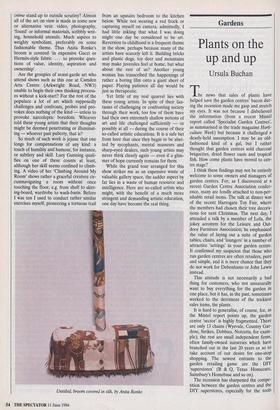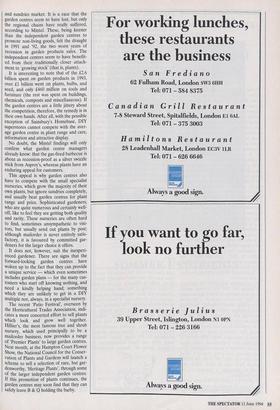Gardens
Plants on the up and up
Ursula Buchan
The news that sales of plants have helped save the garden centres' bacon dur- ing the recession made me gasp and stretch my eyes. It was not because I disbelieved the information (from a recent Mintel report called 'Specialist Garden Centres', as summarised in the trade magazine Horti- culture Week) but because it challenged a dearly-held assumption. I may be an old- fashioned kind of a gal, but I rather thought that garden centres sold charcoal briquettes, dried flower oasis and tropical fish. How come plants have moved to cen- tre stage?
I think these findings may not be entirely welcome to some owners and managers of garden centres. For, as I. discovered at a recent Garden Centre Association confer- ence, many are fondly attached to non-per- ishable retail items. The talk at dinner was of the recent Harrogate Toy Fair, where the members had chosen their tree decora- tions for next Christmas. The next day, I attended a talk by a member of Lofa, the jokey acronym for the Leisure and Out- door Furniture Association; he emphasised the value of laying out a suite of garden tables, chairs, and 'loungers' in a number of attractive 'settings' in your garden centre. It confirmed my suspicion that those who run garden centres are often retailers, pure and simple, and it is mere chance that they do not work for Debenhams or John Lewis instead.
This attitude is not necessarily a bad thing for customers, who not unnaturally want to buy everything for the garden in one place, but it has, in the past, sometimes worked to the detriment of the trickiest sales items, the plants.
It is hard to generalise, of course, for, as the Mintel report points up, the garden centre 'sector' is highly fragmented. There are only 13 chains (Wyevale, Country Gar- dens, Strikes, Dobbies, Notcutts, for exam- ple); the rest are small independent firms, often family-owned nurseries which have branched out in the last 20 years or so to take account of our desire for one-stop shopping. The newest entrants to the garden retailing game are the DIY `superstores' (B & Q, Texas Homecare, Sainsbury's Homebase and so on).
The recession has sharpened the compe- tition between the garden centres and the DIY superstores, especially for the tools
and sundries market. It is a race that the garden centres seem to have lost, but only the regional chains have really suffered, according to Mintel. These, being keener than the independent garden centres to promote non-living goods, felt the draught in 1991 and '92, the two worst years of recession in garden products sales. The independent centres seem to have benefit- ed from their traditionally closer attach- ment to 'growing stock' (that is, plants).
It is interesting to note that of the £2.6 billion spent on garden products in 1993, over £1 billion went on plants, bulbs, and seed, and only £460 million on tools and furniture (the rest was spent on buildings, chemicals, composts and miscellaneous). If the garden centres are a little jittery about the competition, therefore, the remedy is in their own hands. After all, with the possible exception of Sainsbury's Homebase, DIY superstores cannot compete with the aver- age garden centre in plant range and care, information and attractive display.
No doubt, the Mintel findings will only confirm what garden centre managers already know: that the gas-fired barbecue is about as recession-proof as a silver swizzle stick from Asprey's, whereas plants have an enduring appeal for customers.
This appeal is why garden centres also have to compete with the small specialist nurseries, which grow the majority of their own plants, but ignore sundries completely, and usually beat garden centres for plant range and price. Sophisticated gardeners, who are quite numerous and certainly well- off, like to feel they are getting both quality and rarity. These nurseries are often hard to find, sometimes unsympathetic to visi- tors, but usually send out plants by post; although mailorder is never entirely satis- factory, it is favoured by committed gar- deners for the larger choice it offers.
It does not, however, suit the inexperi- enced gardener. There are signs that the forward-looking garden centres have woken up to the fact that they can provide a unique service — which even sometimes includes garden plans — for the many cus- tomers who start off knowing nothing, and need a kindly helping hand; something which they are unlikely to get in a DIY multiple nor, always, in a specialist nursery.
The recent 'Patio Festival', overseen by the Horticultural Trades Association, indi- cates a more concerted effort to sell plants which look and grow well together. Hillier's, the most famous tree and shrub nursery, which used principally to be a mailorder business, now provides a range of 'Premier Plants' to large garden centres. Next month, at the Hampton Court Flower Show, the National Council for the Conser- vation of Plants and Gardens will launch a scheme to sell a selection of rare, but gar- denworthy, 'Heritage Plants', through some of the larger independent garden centres. If this promotion of plants continues, the garden centres may soon find that they can safely leave B & Q holding the barby.



































































 Previous page
Previous page